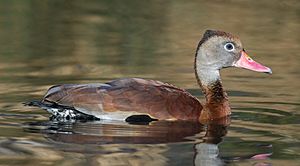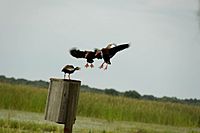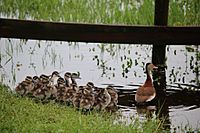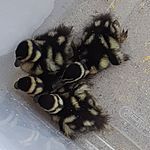Black-bellied whistling duck facts for kids
Quick facts for kids Black-bellied whistling duck |
|
|---|---|
 |
|
| Northern subspecies (D. a. fulgens, note brown breast). The white wing patch, a tell-tale feature of this species, is conspicuous in flight. | |
| Conservation status | |
| Scientific classification | |
| Genus: |
Dendrocygna
|
| Species: |
autumnalis
|
| Subspecies | |
|
D. a. autumnalis (Linnaeus, 1758) |
|
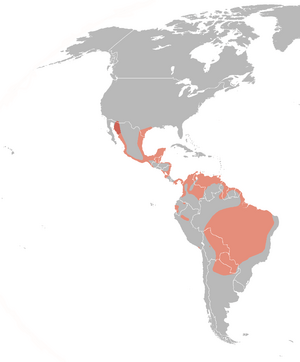 |
|
| Range of D. autumnalis Non-resident Breeding range Resident range | |
| Synonyms | |
|
Anas autumnalis Linnaeus, 1758 |
|
The black-bellied whistling duck (Dendrocygna autumnalis) is a type of whistling duck. It used to be called the black-bellied tree duck. These ducks live and have their babies in the southern United States, Mexico, and warm parts of Central and South America.
In the US, you can see them all year in Florida, parts of Texas, and coastal Alabama. They also visit southeast Arizona and Louisiana's Gulf Coast during certain seasons. Sometimes, they even breed in places like Arkansas, Georgia, Tennessee, and South Carolina. They are now common breeders in central Florida. A large group of hundreds of these ducks spends the winter in Audubon Park in New Orleans, Louisiana.
Since it's one of only two whistling duck types in North America, people sometimes just call it the "whistling duck" or "Mexican squealer" in the southern USA.
Contents
About the Black-bellied Whistling Duck
The black-bellied whistling duck is a medium-sized water bird. It can be about 47 to 56 centimeters (18 to 22 inches) long. It weighs between 652 and 1020 grams (1.4 to 2.2 pounds). Its wings can spread from 76 to 94 centimeters (30 to 37 inches) wide.
This duck has a long red beak and long legs. Its head is pale gray, and most of its body feathers are gray-brown. The belly and tail are black. The rest of its body, back of the neck, and top of the head are a rich chestnut brown color. Its face and upper neck are gray. It also has a thin, clear white ring around its eyes.
When the duck flies, you can easily see the large white parts on its wings. These white parts are from its secondary flight feathers. The main flight feathers are black, and the wing-coverts (feathers covering the wing) are brown. Male and female ducks look very similar. Young ducks look like the adults but have a gray beak and their belly is not as clearly black.
The white bar on its wing is special among whistling ducks. When the duck is on the ground, it might be hard to see the light sides of its body. Another whistling duck, the fulvous whistling duck, also has a whitish stripe on its side. But it has dark wings and a lighter belly, which is different from the black-bellied duck. Young black-bellied ducks look a lot like young white-faced whistling ducks. However, white-faced ducks have a darker beak and no white wing patch.
These ducks are known for being noisy. They make a clear whistling sound that sounds like "waa-chooo."
Types of Black-bellied Whistling Ducks
There are two types, or subspecies, of the black-bellied whistling duck. They mix together in Panama.
- Northern black-bellied whistling duck (D. a. fulgens): This type lives from the southern USA to western Panama. It is larger and has a brown chest and upper back.
- Southern black-bellied whistling duck (D. a. autumnalis): This type lives from eastern Panama to Paraguay and nearby areas. It is smaller and has a gray chest and upper back.
Before 1978, people used the wrong names for these two types.
Duck Life and Habits
The black-bellied whistling duck is a common bird that is quite friendly, even in the wild. They are very social and form large groups when they are not breeding. They usually stay in the same area and don't move far. They often build their nests in hollow trees. In South America, they often use palm trees.
These ducks like quiet, shallow freshwater areas. This includes ponds, lakes, and marshes. They also live in farm fields or reservoirs that have lots of plants. They mostly eat seeds and other plant food, usually at night.
-
In Tobago
-
Black-bellied whistling ducks rarely move long distances, but these birds were seen near Saltsburg in Pennsylvania. They may be vagrants or escaped from aviculture.
-
An adult Black-bellied Whistling Duck and sixteen ducklings in Parrish, Florida
What They Eat
These ducks often eat at night, but you can see them eating any time of day. Black-bellied whistling ducks eat many different kinds of plants. They also eat insects and small water animals when they can find them. They often find food by walking through shallow water and eating plants that are underwater. As their Latin name autumnalis suggests, they are often seen picking up leftover seeds and small creatures from fields after crops have been harvested.
Where They Go
The black-bellied whistling duck usually does not migrate long distances. Ducks in the very northern parts of their home range, like Arizona, Louisiana, and parts of Texas, move south for the winter. In the middle of their range, they tend to travel in groups during winter. This is not a long migration but more like moving around locally.
For example, a group of ducks has been seen in Lake County, Florida, since 2009. Adult pairs with their young are seen near lakes and wetlands in towns like Eustis and Leesburg. Large groups of over 30 birds can be seen throughout the county in winter. A big group has also been seen for about two years in Parrish, Florida. This group returns every year to nest in a marshy area. In February 2016, a large group was seen in Audubon Park, New Orleans, Louisiana. More than 100 whistling ducks have lived in Gum Slough in Sumter County, Florida, for over two years. Since late 2019, a group of over 100 ducks has lived by Lake Roberta in Tampa, Florida.
Reproduction and Family Life
The black-bellied whistling duck is special among ducks because pairs stay together for many years. This strong bond is more common in geese and swans. Both parents help raise their young. They share all the jobs, from sitting on the eggs to taking care of the ducklings.
These ducks usually nest in hollow trees. But if they need to, they will nest on the ground. They also use chimneys, old buildings, or special nest boxes. People have been putting out more nest boxes for them in places like southeast Texas and Mexico. Ducklings jump out of their nests within two days of hatching. They can find their own food right away and stay with their parents for up to eight weeks.
How They Are Doing
The black-bellied whistling duck is listed as a species of least concern by the International Union for Conservation of Nature (IUCN). This means they are not in danger. There are an estimated 1,100,000 to 2,000,000 of these birds in the world, and their numbers are growing.
See also
 In Spanish: Suirirí piquirrojo para niños
In Spanish: Suirirí piquirrojo para niños



